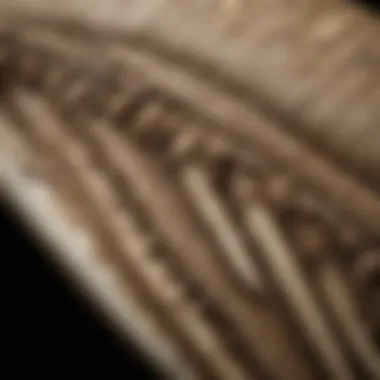Unveiling the Enigmatic Trade of Woolly Mammoth Bones


Rock and Fossil Identification
When delving into the realm of woolly mammoth bones for sale, it is essential to have a solid understanding of rock and fossil identification. Various types of rocks and fossils can house these ancient treasures, each with unique characteristics that set them apart. As a collector, honing your ability to discern between different types of rocks and fossils is crucial.
Collecting Tips and Techniques
Exploring the availability of woolly mammoth bones can be an exhilarating experience for collectors. To ensure successful acquisitions, it is important to follow best practices for collecting. Locating prime collecting sites where these relics are still accessible is key. Additionally, knowing how to safely extract specimens without causing damage is paramount.
Preservation and Display
Preserving woolly mammoth bones is vital to maintain their integrity and value over time. Implementing effective techniques for preservation is essential in preventing deterioration. Proper storage methods, such as controlled environments to avoid excessive humidity or temperature fluctuations, can contribute significantly to the longevity of these precious artifacts. Furthermore, creative display ideas can allow collectors to showcase their prized possessions in unique and captivating ways.
Geological Insights
Gaining geological insights into the world of woolly mammoth bones adds layers of fascination to the collecting process. Understanding the geological formations and processes that contribute to the preservation of these relics offers valuable context. Exploring the historical significance of rocks and fossils, particularly in the context of woolly mammoths, can shed light on the prevailing conditions during the Pleistocene era. Additionally, delving into notable discoveries in the field provides a glimpse into the rich tapestry of paleontological findings.
Introduction
In delving into the intriguing world of woolly mammoth bones available for sale, we uncover a realm enriched with historical allure and contemporary significance. The allure of these ancient relics transcends mere fascination, tapping into a profound connection with our prehistoric past. Exploring the mystique surrounding woolly mammoth bones offers a unique glimpse into an era long gone, sparking curiosity and wonder among collectors and enthusiasts alike. Furthermore, understanding the historical context of woolly mammoth discoveries sheds light on the scientific importance and cultural value attached to these majestic creatures.
Uncovering the Mystique
The Allure of Woolly Mammoth Bones
The allure of woolly mammoth bones lies in their enigmatic charm, symbolizing a link to a bygone era when these magnificent creatures roamed the earth. Collectors are drawn to the mystique surrounding mammoth bones, their sheer size and remarkable preservation capturing the imagination of fossil enthusiasts worldwide. The rarity and uniqueness of woolly mammoth bones make them a prized choice for collectors seeking to own a piece of natural history. Despite their age, these fossils offer a tangible connection to a distant past, enriching collections with a touch of ancient grandeur.
Historical Context of Woolly Mammoth Discoveries
Exploring the historical context of woolly mammoth discoveries provides a deeper understanding of the scientific significance and cultural impact of these magnificent creatures. From early excavations to modern-day paleontological endeavors, each discovery contributes to our knowledge of prehistoric fauna and ecosystems. The legacy of woolly mammoth discoveries spans centuries, with each find adding layers to our comprehension of Earth's history. Unearthing the past through mammoth bones not only enriches scientific research but also piques public interest in the world of paleontology.
Significance in Collecting Circles


Interest of Collectors in Woolly Mammoth Bones
The interest of collectors in woolly mammoth bones stems from a fascination with these ancient relics and the stories they hold within their fossilized remains. Enthusiasts are captivated by the sheer magnitude of mammoths and the mystery shrouding their existence, making mammoth bones a coveted addition to private collections. The allure of owning a piece of natural history drives collectors to seek out these prehistoric treasures, igniting a passion for discovery and preservation within the collecting community.
Value and Rarity of These Prehistoric Remains
The value and rarity of woolly mammoth bones represent a unique investment opportunity for collectors looking to acquire exceptional pieces of paleontological heritage. The scarcity of intact mammoth remains coupled with their cultural significance contributes to their high value in collecting circles. Owning a woolly mammoth bone not only bestows prestige upon a collection but also serves as a tangible reminder of Earth's ancient past, making these artifacts highly sought after in the world of fossil acquisition.
Market Overview
Availability of Woolly Mammoth Bones for Sale
The availability of woolly mammoth bones for sale varies depending on factors such as excavation efforts, legal regulations, and market demand. While some pieces are readily accessible through reputable sellers and auction houses, others remain elusive due to limited supply and conservation concerns. Understanding the market dynamics behind mammoth bone availability is essential for collectors looking to acquire these prized fossils for their personal collections or investment portfolios.
Key Players in the Woolly Mammoth Bone Market
Within the woolly mammoth bone market, key players encompass a diverse range of stakeholders, including auction houses, private sellers, and paleontological institutions. Each entity contributes to the dissemination and trade of mammoth bones, playing a crucial role in connecting collectors with these valuable artifacts. Recognizing the influence of key players in the market sheds light on the mechanisms driving the circulation and appreciation of woolly mammoth bones among discerning collectors and enthusiasts.
Sourcing Woolly Mammoth Bones
In the exploration of woolly mammoth bones available for sale, understanding the sourcing process is paramount. Delving into the depths of sourcing woolly mammoth bones provides enthusiasts and collectors with a glimpse into the journey these prehistoric artifacts take from the icy permafrost to potential auction houses or online platforms. Analyzing the sourcing methods sheds light on the meticulous efforts that go into excavating these valuable remains.
Expeditions and Discoveries
Methods of sourcing woolly mammoth bones
Exploring the methods of sourcing woolly mammoth bones uncovers the intricate process of locating and extracting these ancient treasures. From traditional excavation techniques to cutting-edge technology like ground-penetrating radar, each method plays a crucial role in unearthing mammoth remnants. The utilization of such methods not only enhances the efficiency of bone retrieval but also ensures the preservation of these delicate fossils. Understanding the nuances of each sourcing method enriches the appreciation for the scientific precision involved in acquiring woolly mammoth bones.
Notable expeditions in search of mammoth remains
Highlighting the notable expeditions embarked upon in search of mammoth remains showcases the tenacity and dedication of researchers and paleontologists. These expeditions often span across remote and challenging terrains, braving harsh conditions in pursuit of key discoveries. The narratives of these expeditions not only reveal fascinating tales of exploration but also contribute significantly to expanding our knowledge of woolly mammoth habitats and behaviors. Each expedition leaves a trail of scientific breakthroughs and historical insights, shaping the collective understanding of woolly mammoths' existence.


Ethical Considerations
Exploring the ethical dimensions of acquiring and trading woolly mammoth bones adds a layer of complexity to the pursuit of these relics. Addressing the legal aspects surrounding mammoth bone procurement illuminates the regulatory frameworks that govern the possession and sale of these artifacts. Considerations of ethics delve into the moral implications of commercializing prehistoric remains, sparking debates on the boundaries of preservation and profit. Navigating the intersections of legality and ethics in the woolly mammoth bone market requires a nuanced approach that balances scientific curiosity with ethical responsibility.
Legal aspects of acquiring mammoth bones
Dissecting the legal landscape of acquiring mammoth bones underscores the intricate regulations that govern the ownership and trade of these prehistoric specimens. Compliance with international agreements and national laws is crucial in ensuring the legitimacy of mammoth bone transactions. The legal framework provides a robust foundation for safeguarding these valuable artifacts and mitigating the risks of illicit trade or exploitation. Understanding the legal nuances surrounding mammoth bone acquisition is essential for collectors and dealers alike to navigate the market responsibly.
Ethical implications of buying and selling prehistoric artifacts
Exploring the ethical implications tied to the trade of prehistoric artifacts prompts reflection on the ethical dilemmas inherent in commodifying ancient history. The ethical considerations extend beyond legal compliance to encompass broader ethical principles of respect for cultural heritage and promotion of scientific integrity. Discussions on the ethical dimensions of buying and selling mammoth bones catalyze conversations on conservation, cultural sensitivity, and community engagement. Balancing the commercial aspects of the market with ethical values requires conscientious decision-making and a commitment to preserving the heritage encapsulated within woolly mammoth bones.
Exploring Acquisition Opportunities
Investing in prehistoric relics like woolly mammoth bones is a unique and captivating venture that offers a glimpse into our ancient world. This section delves into the acquisition opportunities available in the market, shedding light on avenues for collectors to explore and invest in these precious artifacts. Understanding the significance of acquiring mammoth bones not only adds to personal collections but also contributes to the preservation and appreciation of our prehistoric heritage.
Auction Houses and Online Platforms
Top auction houses specializing in mammoth bones
Delving into the world of auction houses that specialize in woolly mammoth bones opens up a realm of curated selections and expert curation. These top auction houses meticulously source, verify, and present mammoth bones of exceptional quality, attracting seasoned collectors and enthusiasts alike. Offering a blend of authenticity and rarity, these auction houses serve as hubs where heritage meets acquisition, making them a desirable choice for enthusiasts seeking premium mammoth bones. The distinctive feature of these top auction houses lies in their ability to showcase unique pieces with detailed provenance, providing transparency and assurance to buyers. However, the exclusivity of these auction houses may pose challenges for entry-level collectors, necessitating thorough research and understanding of the market.
Online channels for purchasing woolly mammoth remains
The emergence of online platforms has revolutionized the accessibility of woolly mammoth bones, catering to a broader audience of collectors worldwide. Online channels create a virtual marketplace where buyers can explore an extensive range of mammoth remains, from individual bones to complete skeletal elements. The convenience of online purchases offers flexibility and convenience, allowing collectors to browse, compare, and acquire mammoth bones from the comfort of their homes. One notable advantage of online platforms is the diverse options available, accommodating varying budgets and preferences. However, the lack of physical inspection and potential risks associated with online transactions require cautious decision-making and thorough attention to authenticity and seller reputation.
Factors to Consider
Authentication and certification of mammoth bones
The process of authenticating and certifying mammoth bones is a critical aspect that ensures the integrity and value of these ancient artifacts. Experienced professionals and institutions specializing in paleontology and fossil authentication play a vital role in verifying the authenticity of mammoth bones, utilizing advanced techniques such as carbon dating and morphological analysis. Authentication not only validates the origin and age of the bones but also provides buyers with assurance regarding the legitimacy of their acquisitions. While certified mammoth bones command higher market value and credibility, the authentication process may involve additional costs and time, impacting the overall investment.


Investment potential and long-term value
Evaluating the investment potential and long-term value of woolly mammoth bones requires a strategic approach that considers market trends, rarity, and desirability. These prehistoric relics carry inherent historical and scientific significance, making them attractive assets for long-term preservation and appreciation. Factors such as specimen quality, provenance, and scarcity influence the investment value of mammoth bones, with well-preserved specimens often commanding premium prices in the market. Understanding the fluctuating demand for mammoth bones and predicting future trends are essential considerations for collectors looking to build a comprehensive and valuable collection. While investing in mammoth bones offers unique opportunities for growth and esteem, prudent decision-making and expert guidance are imperative to maximize returns and sustainability.
Tips for Aspiring Collectors
Guidance on starting a woolly mammoth bone collection
For aspiring collectors venturing into the realm of mammoth bone acquisition, seeking guidance from experienced collectors and paleontologists can provide invaluable insights and direction. Establishing clear collecting objectives, such as focusing on specific bone types or periods, aids in narrowing down choices and building a cohesive collection. Collaborating with reputable dealers and attending industry events contribute to expanding knowledge and networking within the collecting community, fostering a deeper appreciation for mammoth bones as significant historical remnants.
Preservation techniques for ancient fossils
Preservation plays a pivotal role in maintaining the integrity and lifespan of mammoth bones, safeguarding their scientific value and aesthetic appeal. Implementing proper handling procedures, storage protocols, and climate control measures are essential practices for ensuring the longevity of these delicate relics. Utilizing archival materials, such as acid-free containers and silica gel desiccants, helps mitigate environmental risks and prevent deterioration caused by moisture or light exposure. Engaging in regular maintenance and inspection of mammoth bones, along with consulting conservation experts when necessary, enhances their preservation and enhances their aesthetic and historical value over time.
Educational Insights and Conservation Efforts
In the realm of woolly mammoth bones available for sale, delving into Educational Insights and Conservation Efforts holds paramount importance. Understanding the historical significance and archeological value of these prehistoric remains is crucial to appreciating their contribution to science and humanity. Exploring Educational Insights sheds light on the past, connecting us to a bygone era through tangible artifacts. Conservation Efforts, on the other hand, serve to preserve these precious relics for future generations, ensuring that the fascinating world of woolly mammoths remains accessible and protected.
Educational Outreach
Role of museums in showcasing mammoth specimens
The Role of museums in showcasing mammoth specimens plays a pivotal role in educating the public about these ancient giants. Museums serve as custodians of history, offering a captivating glimpse into the world of mammoths through carefully curated exhibits and interactive displays. By showcasing mammoth specimens, museums not only educate visitors about the biology and behavior of these colossal creatures but also raise awareness about conservation efforts and paleontological research. This aspect is essential in bridging the gap between the past and the present, fostering a deeper appreciation for the natural world and our collective heritage.
Educational programs on paleontology and prehistoric life
Educational programs on paleontology and prehistoric life play a crucial role in disseminating knowledge about the science of paleontology and the lifestyles of prehistoric organisms. These programs provide enthusiasts with a unique opportunity to explore the world of ancient flora and fauna, offering insights into evolutionary processes, environmental dynamics, and adaptations over time. By engaging in educational programs on paleontology and prehistoric life, individuals can expand their understanding of Earth's history and gain a newfound appreciation for the complexities of our planet's past.
Conservation Initiatives
Efforts to protect mammoth bone sites
Efforts to protect mammoth bone sites are instrumental in safeguarding these invaluable archeological treasures from looting, degradation, and environmental threats. By implementing stringent security measures and surveillance, organizations and authorities can effectively deter illicit activities and ensure the preservation of mammoth bone sites for scientific study and public enjoyment. Protecting these sites not only contributes to broader conservation objectives but also upholds ethical standards in the field of paleontology, emphasizing the importance of responsible stewardship and sustainable practices.
Impact of climate change on permafrost preservation
The Impact of climate change on permafrost preservation poses a significant challenge to the long-term survival of mammoth remains and other frozen fossils. As rising temperatures thaw Arctic permafrost at an unprecedented rate, the integrity of these frozen specimens becomes increasingly susceptible to decay and damage. This phenomenon not only jeopardizes the scientific value of mammoth bones but also underscores the urgent need for climate action to mitigate the adverse effects of global warming on paleontological resources. Understanding the impact of climate change on permafrost preservation is paramount in devising conservation strategies to protect these precious remnants of Earth's ancient past.







